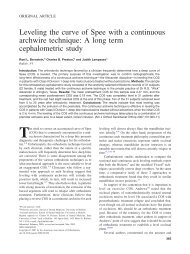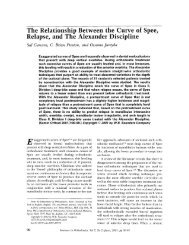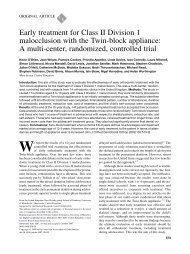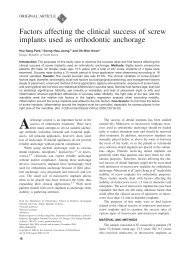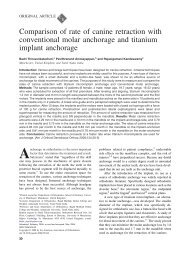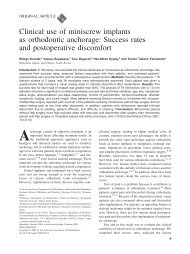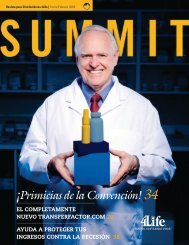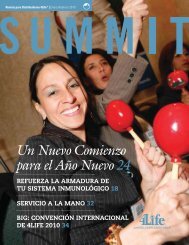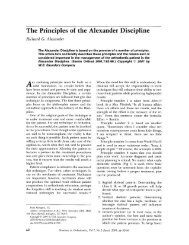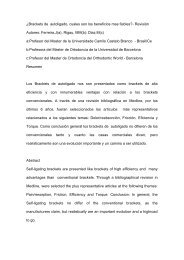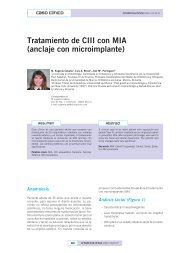Biomechanical and histological comparison of self-drilling and self ...
Biomechanical and histological comparison of self-drilling and self ...
Biomechanical and histological comparison of self-drilling and self ...
You also want an ePaper? Increase the reach of your titles
YUMPU automatically turns print PDFs into web optimized ePapers that Google loves.
American Journal <strong>of</strong> Orthodontics <strong>and</strong> Dent<strong>of</strong>acial Orthopedics<br />
Volume 133, Number 1<br />
Table II. Comparison <strong>of</strong> peak removal torque values<br />
between groups (in Ncm)<br />
Group (n 6 each group) STI SDI P<br />
Maxilla 5.7 2.3 6.5 2.2 NS<br />
M<strong>and</strong>ible 6.1 0.5 7.1 2.0 NS<br />
NS, P .05.<br />
Fig 3. Bone implant interfaces: A, SDI; B, STI (20X<br />
original magnification).<br />
ences between the 3 groups in the maxilla <strong>and</strong> the<br />
m<strong>and</strong>ible (Table I).<br />
The <strong>comparison</strong> <strong>of</strong> mean PRT showed no statistically<br />
significant difference between the 2 groups after 9<br />
weeks (Table II).<br />
Histologic assessment showed good histocompatibility,<br />
with various bone structures interspersed with<br />
fibrous connective tissues around the microimplants in<br />
both groups (Fig 3). Better osseous tissue formation<br />
around the microimplants <strong>and</strong> greater original bone<br />
were seen in the SDI group than in STI group, as<br />
evidenced by calcein <strong>and</strong> oxytetracycline labeling.<br />
Remodeling <strong>and</strong> apposition were seen more in the SDI<br />
group than in STI group (Fig 4).<br />
BIC values are shown in Table III.<br />
DISCUSSION<br />
After the 9-week period, an important finding in<br />
this study was the high success rates <strong>of</strong> the SDI <strong>and</strong> the<br />
STI groups. The results confirmed our original deduction<br />
<strong>of</strong> greater success in the SDI group (93%) than in<br />
Chen, Shin, <strong>and</strong> Kyung 47<br />
the STI group (86%). Two microimplants failed in the<br />
SDI group; 1 loosened, <strong>and</strong> the other fractured in the<br />
fourth week. In a similar animal experiment, Kim <strong>and</strong><br />
Chang 21 observed a higher success rate in miniscrews<br />
in the drill-free group than in the drill group with a<br />
1-week healing period.<br />
The main reason for the failures might have been<br />
the poor initial stability caused by early loading <strong>and</strong> the<br />
exposed healing situation. This was confirmed in the<br />
19<br />
pig experiment <strong>of</strong> Heidemann et alwith<br />
a 100%<br />
success rate in the groups <strong>of</strong> <strong>self</strong>-<strong>drilling</strong> screws (SDS)<br />
<strong>and</strong> <strong>self</strong>-tapping screws (STS), which healed in a closed<br />
situation <strong>and</strong> without force.<br />
Because <strong>of</strong> early loading in our study, the microimplants<br />
stayed in the bone with mechanical interlock<br />
without bone <strong>and</strong> implant osseointegration at the be-<br />
1<br />
ginning <strong>of</strong> the experiment. Roberts et demonstrated<br />
al<br />
that immediate loading was deleterious to implant<br />
stability in their animal study. However, SDIs have<br />
been proven to have greater strength <strong>and</strong> highly mechanical<br />
friction with bone to keep initial stability <strong>and</strong><br />
to resist micromovement.<br />
19 Initial stability was be -<br />
lieved to play an important role in the success <strong>of</strong> our<br />
interradicular microimplants that healed in exposed<br />
situations. 22<br />
PIT, which exhibited the holding strength to resist<br />
loosening <strong>and</strong> loss <strong>of</strong> the implants, was measured at the<br />
beginning <strong>of</strong> the experiment for each microimplant in<br />
both groups. The mean PIT values <strong>of</strong> the SDIs in the<br />
maxilla <strong>and</strong> the m<strong>and</strong>ible were 5.6 <strong>and</strong> 8.7 Ncm,<br />
respectively. In the STI group, PIT values were 3.5<br />
Ncm for the maxilla <strong>and</strong> 7.4 Ncm for the m<strong>and</strong>ible. PIT<br />
values were found to be significantly different between<br />
the SDI <strong>and</strong> STI groups, both in the maxilla <strong>and</strong> the<br />
m<strong>and</strong>ible, but lower in the maxilla. Our results were<br />
similar to those from the clinical experiment <strong>of</strong> Schon<br />
et al 23 for craniomaxill<strong>of</strong>acial procedures; they found<br />
that insertion torque <strong>of</strong> the SDS was higher compared<br />
with that <strong>of</strong> the STS in humans. Microimplants with<br />
high PIT might have closer initial contact with bone<br />
<strong>and</strong> might be good for bone remodeling. From an anchorage<br />
perspective, the greater the contact between the<br />
surface <strong>of</strong> the microimplant threads <strong>and</strong> the cortical bone,<br />
24,25<br />
the higher the initial grip <strong>of</strong> microimplants would be.<br />
Fracture is a disadvantage <strong>of</strong> microimplants even<br />
when they are placed without excessive force. The<br />
results showed high PIT values for thin-diameter microimplants,<br />
<strong>and</strong> high bone density might be dangerous<br />
to SDIs. According to the principle <strong>of</strong> conservation <strong>and</strong><br />
transformation <strong>of</strong> energy, SDIs have higher pressure<br />
than STIs, <strong>and</strong> pretapped implants were placed after the<br />
pilot holes were drilled. Even though SDIs have many<br />
advantages, if the bone is dense, they should not to be



